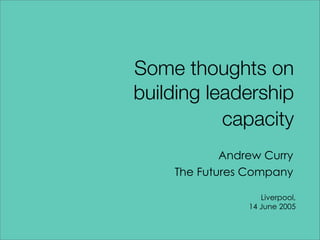
Some thoughts on building leadership capacity
- 1. Andrew Curry The Futures Company Liverpool, 14 June 2005 Some thoughts on building leadership capacity
- 2. 2 Franklin and the North West passage
- 3. 3 Amundsen’s approach was leaner
- 4. 4 Complicated vs. complex: bricks and birds • Complicated − all components are knowable and definable − they can be catalogued − all relationships can be listed − cause and effect can be understood and replicated − It is the sum of its parts • Complex − many interacting agents with multiple identities − if you alter an agent the effect is unpredictable − cause and effect are intertwined − it is not the exact sum of its parts Source: Jake Chapman, Demos
- 5. 5 The brick school of management “I only have three things to do. I choose the right people. I allocate the right number of dollars. And I transmit ideas from one division to another with the speed of light” (Jack Welch)
- 6. 6 Engineering assumptions about leadership •Leaders as head, organisation as body •The premise of predictable change •The assumption of cascading intention Richard Pascale, Surfing The Edge of Chaos
- 7. 7 The limits of engineering models of leadership Richard Pascale, Surfing The Edge of Chaos “Faced with the practical needs for significant change, we opt for the hero-leader rather than eliciting and developing leadership capacity throughout the organisation… The evidence for top managementʼs power to direct large organisations to change is thin at best” Peter Senge
- 8. 8 ‘The new leadership agenda’ •Organisations are not machines, but living systems −Based on complexity theory and ʻnew scienceʼ •Outcomes are uncertain and unstable, so leaders need to be adaptive •Organisations need to agree on purposes – shared intent is more valuable than rules •To building capability within organisations you need to increase −The size of the ʻnodesʼ or meeting/exchange points −The number of connections between the nodes •The balance between ʻdesignʼ and ʻemergenceʼ has to be found by trial and error
- 9. 9 “I build up networks, increase the organisationʼs connectivity, and amplify the voices of employees who would not otherwise be heard. As a consequence, the organisationʼs ability to learn increases.” (Angelika Siegmund) Quoted in Fritjo Capra, The Hidden Connections
- 10. 10 From classical music to playing jazz "Then, there was this huge battle space and we knew just about everything about it … All one had to do was adhere to the tactical doctrine that flowed from Nato's general defence plans. I was akin to second violin in a symphony orchestra. “These days, I have to play jazz." Air Vice Marshal Brian Burridge, 2001
- 11. 11 Leadership and managing through turbulence “When we hit the turbulence, the conventional planning tools wouldnʼt work. You could have done business, but it wouldnʼt have been good business”. (Chris Yapp, speaking of ICL) Intended strategy Realised strategy/ New insight Possible emergent strategy Possible emergent strategy Turbulence Sources: Max Boisot, [1996]; Understanding best practice in strategic futures work, Henley Centre (2001)
- 12. 12 What leaders should be •Inspiring − Create conditions that foster openness and release energy •Caring − Spend more time preventing problems than fixing them •Infusing − Change that seeps in slowly, steadily, profoundly# •Initiating − Listens to whatʼs rising up from the base, rather than parachuting initiatives into the the organisation “The manager is not the organisation, any more than a picture of a pipe is a pipe” Henry Mintzberg
- 13. 13 “We did not put our ideas together. We put our purposes together. And then we agreed, and then we decided” From the ʻPopol Vuhʼ, quoted in Adam Kahane, ʻSolving Tough Problems'
- 14. Andrew Curry The Futures Company e: andrew.curry@thefuturescompany.com b: http://thenextwavefutures.wordpress.com/ t: http://twitter.com/nextwavefutures